RULER OF THE MATHEMATICIANS' DOMAIN
Illustrated by John C. Holden
Historians generally dismiss with contempt the notion that mathematicians once dominated a glorious era of human history. We here relate a portion of that dubious history, reconstructed from discrete fragments into a piecewise continuous narrative which, unfortunately, won't be fully coherent.
 he earliest civilization of mathematicians
emerged during the late Stochastic era, when
primitive tribes migrated from the Planes of Euclid,
through the Dedekind Cut, to the Kronecker
Delta. There they found relatively prime
agricultural land, where they settled and multiplied.
When locus plagues repeatedly wiped out their lemma
groves, they abandoned the area and took to the
forests, grubbing for square roots to sustain
themselves.
he earliest civilization of mathematicians
emerged during the late Stochastic era, when
primitive tribes migrated from the Planes of Euclid,
through the Dedekind Cut, to the Kronecker
Delta. There they found relatively prime
agricultural land, where they settled and multiplied.
When locus plagues repeatedly wiped out their lemma
groves, they abandoned the area and took to the
forests, grubbing for square roots to sustain
themselves.Others migrated to the higher planes, seeking purer air, where they enjoyed the exhilaration from having their heads in the clouds. There they founded the kingdom of Summaria. Unfortunately this group succumbed to disease--the dreaded Lipschitz condition--which kills by excruciating attacks of Kurtosis.
 |
| An attack of kurtosis |
|---|
In the aftermath of these disasters, the remainder of the mathematicians dispersed into numerous local groups. One of these inhabited the insignificant province of Outer Automorphism. Here was born, of humble origin, a man destined to lead the mathematicians to their greatest glory. His name was Sam Schwartz.
Sam's military victories were frequently recounted with awe. In battle he skewed his enemies right and left. He brilliantly confounded the Mesokurtic Hordes in the battle of the Konigsburg bridges. His foes could not determine how to traverse the last bridge without retreating, so, taking advantage of their confusion, Sam forged ahead to capture the Tower of Hanoi. His greatest triumph came when he drove the rebellious Surds from his domain. Through protracted hostilities against intransitive enemies, Sam prevailed. Eventually all of his enemies' unions were divided, and their forces decimated.
 |
| A rebellious Surd |
|---|
Still, his ambition was unbounded. Through a process of integration by parts, he unified the diverse fractions one by one into an empire. Thus he brought peace to all lands within his compass, which included the area from the Dyadic trace to the Jordan curve. Finally, weary of battle, Schwartz turned reflexive, realizing that military conquest was all for nought. He normalized relations with adjoining domains, then turned his attention to peace and domestic affairs. For a while, everything seemed affine.
Schwartz was revered as a singular ruler, a statesman of first rank. His royal decrees demonstrated that he was an exponent of rationality. Schwartz was respected as a man who rigorously held to first principles. His rectilinearity was without parallel.
Scwartz demonstrated that he was asymptotic to the plight of the poor when he declared a distributive law to eliminate inequality and ensure increased degrees of freedom. When called upon to adjugate disputes between divergent fractions, he used all of his powers of attenuation to analyze the complex arguments and reach an equitable solution.
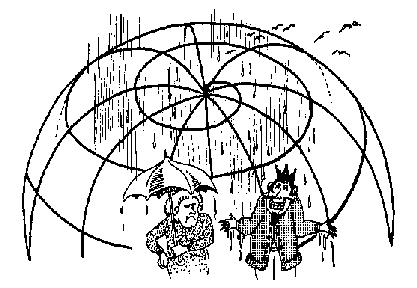 |
| Sam's Loxodrome. |
|---|
At the apex of his power, Schwartz built an elegant palace, the Loxodrome. Adjoining it was a university devoted to science, art, music, and mathematics. This school was constructed on the premises so he could more frequently consult with the faculty. Never content with the least common denominator, Schwartz promoted excellence in all functions of his royal court.
In his later years, Schwartz's behavior became singularly eccentric. He lost his powers of differentiation and sometimes even seemed indefinite about integrals. His character was transformed. He even took up an odd religion, spending interminable periods seated in the locus position by the light of the Lune, meditating on a point of inflection.
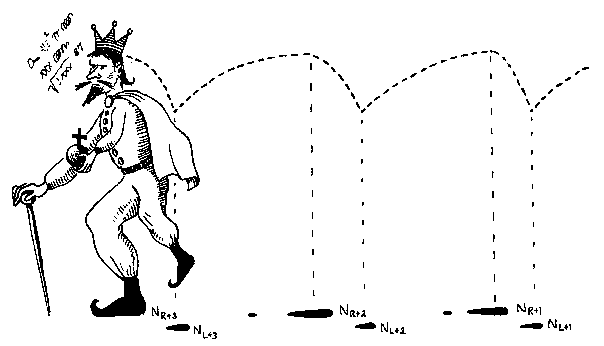 |
| Sam became eccentric. |
|---|
He tolerated numerous deviations and inversions in his court. Rumors circulated that the palace was rife with homomorphisms, and Schwartz himself was suspected of convoluting with a trisectrix. (This was probably untrue, since historians suspect Schwartz was idempotent.)
The palace became a center of isometry and reversion. Some in the court developed an inclination toward mystical philosophies. Persons of high rank frequently attended transcendental functions where they tended to go to extrema. Many were addicted to trivial solutions which induced hyperbolic behavior. When in their cusps they were only capable of weak convergence.
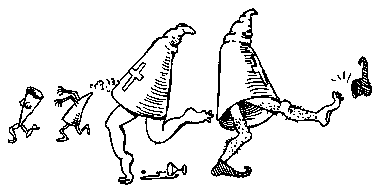 |
| Deviant Conics. |
|---|
Even the Church was corrupted by degenerate Conics of deviant declinations. The Church had achieved a position of undue power. Its Cardinal number had become excessive, and its entire hierarchy was riddled with corruption right down to the level of the local Curtate.
To add to these problems, the government bureaucracy had become oblate. Taxes were recursive. A study by the general counting office concluded that the royal treasury's calculations just didn't compute. The finance minister, Pierre Charlier, had decimated the treasury by applying undetermined multipliers to the budget. Checks issued over his signature, Charlier checks, bounced.
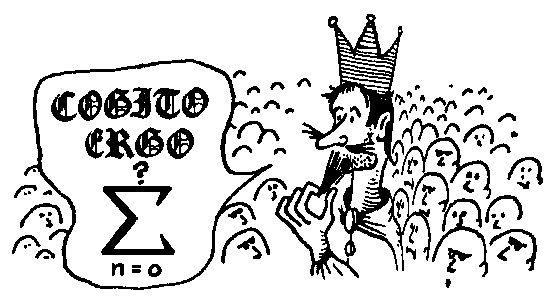 |
| Sam's speeches were incoherent. |
|---|
Schwartz's speeches became incoherent. He frequently made invalid statements. His decree to realign the province boundaries by a devious conformal mapping provoked negative reaction. Popular sentiment finally turned against Schwartz when he began to dispense justice arbitrarily. Frustrum and outrage at Schwartz's inequality provoked many to call him ``Regula Falsi!''
Diverse fractions harbored a sense of inequality. Many felt their involute rights were circumscribed. His subjects no longer trusted his word. His confidence interval was reduced to the vanishing point.
Schwartz seemed unaware of the magnitude of this coefficient of alienation. He took a lacunary attitude toward rumors of coversed activities against him. He rationalized these as merely an insignificant product of regression among the common factors and vulgar fractions of the population.
 |
| Tortured on the tractrix. |
|---|
The police had regressed to meanness, and were a force to be reckoned with. They were determined to circumvent inclinations toward revolution. Citizens suspected of regressive tendencies were taken to the interrogation center to be subjected to third degree equations. Intransitive suspects were tortured on the dreaded tractrix, which could render victims disjoint. The inquisitors were expert at extracting information by the method of exhaustion. Summary trials became the rule, and the prisms were soon filled.
Even some in Schwartz's own court were outraged at his propositions. A subgroup of the supposedly loyal palace Quaternions formed an axis of revolution to plot Schwartz's downfall. From that point, Schwartz's days were numbered.
Their first plot, to drown Schwartz in a Cartesian well, had to be abandoned, for it was the dry season. At a royal banquet for the Italian ambassador, they slipped an extract of limacon tree kernels into Schwartz's riccati. Their calculation of the Poisson ratio was incorrect, and Schwartz only suffered an attack of nausea, which responded to a stiff dose of Euler's formula, administered by a parametric.
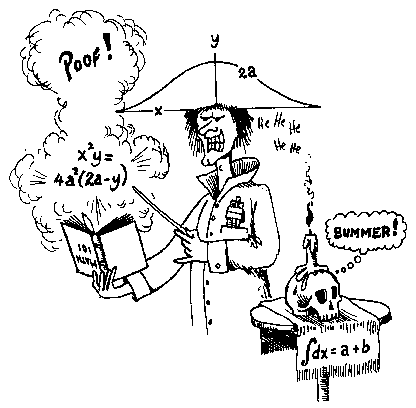 |
| The Witch of Agnesi casts a spell. |
|---|
In desperation they enlisted the aid of the wicked witch of Agnesi to cast a cursoid spell on Schwartz. Her mischievous pet gnomon iterated the numbers of her magic square, causing it to give faulty sums. Its attenuated power merely gave Schwartz a mild case of strophoid fever. After a brief stay in L'Hospital, where he was given homeothetic medicines, he fully recovered.
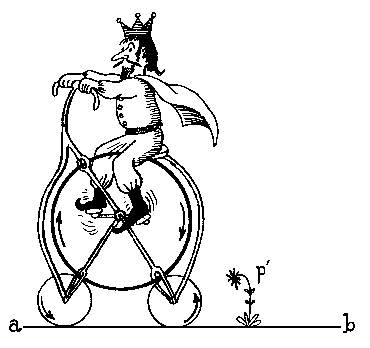 |
| Sam rides his epicycle. |
|---|
Still, Schwartz was unaware of these radical plots, and of those fomenting a convolution against him. Thus, he was taken by surprise and assassinated by a hired annihilator, while riding his epicycle on his way to a council meeting at the folium.
Schwartz's funeral was a magnificent function. As he lay in state (at the traditional angle of repose), his soul was commended to the higher powers. Both his friends and his enemies united in wishing that Schwartz would find peace in the Noether World. His mortal residue was encrypted in the royal barycenter, alongside Napier's bones, and a strange bottle containing Klein's ashes.
EXERCISES:
- Identify each mathematical term [mis]used in this essay. Give its proper definition. How many are there?
- How many mathematical curves are thrown at you in this essay? Define and sketch each one. Which of these show up in John Holden's drawings?
- How many surds are in the drawing of the "rebellious Surd''?
ENDNOTE:
One reader of this little fairy tale took me to task for "picking on a real mathematician.'' I hope readers do not mistake my fictitious Sam Schwartz for Hermann Amandus Schwartz (1843-1921), who does have an inequality named for him. My fictional Pierre Charlier is not to be confused with Carl Vilhelm Ludvig Charlier (1862-1934), who was so often confused by calculations that he invented computational checks which now carry his name (a name long enough to need something to carry it.) Charlier's bank checks were, so far as I know, good as gold. Mathematician Amalie Noether passed on in 1935, and we have no reason to suppose that her mathematical soul went to a nether world. Anyway, wherever she may or may not be, we aren't likely to get any letters of complaint from her, or any of the other mathematicians mentioned in this story.
 This material is © 2001 by
The Institute of Physics Publishing and appears in the
science humor collection
Science Askew
by Donald E. Simanek and John C. Holden.
Look for a good price on the web.
This material is © 2001 by
The Institute of Physics Publishing and appears in the
science humor collection
Science Askew
by Donald E. Simanek and John C. Holden.
Look for a good price on the web.
![]() Input and suggestions are welcome at
the address shown to the right.
When commenting on a specific document, please reference it
by name or content.
Input and suggestions are welcome at
the address shown to the right.
When commenting on a specific document, please reference it
by name or content.